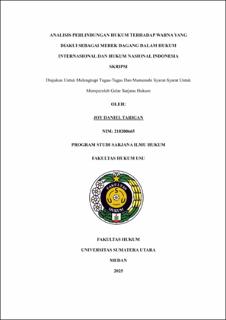| dc.description.abstract | The use of color as a recognized trademark, analyzing its registration,
regulation, constraints, and legal protection from the perspectives of international
and Indonesian national law. As the role of color becomes increasingly vital in
brand identity and competitiveness in the global market, an urgent need for
harmonization and legal certainty emerges. This study employs a normative
juridical research method with a statutory approach, a comparative approach, and
case approach to analyze existing regulations.
The findings show that under the TRIPS Agreement international law
recognises protection for combinations of colours provided those combinations
have distinctiveness acquired through use that can be verified through secondary
meaning and provided they are not functional. Because TRIPS allows each member
to decide how to apply these provisions, advanced jurisdictions such as the United
States and Australia also protect single colour. A landmark decision such
as Louboutin v. YSL confirms that colour marks can obtain narrowly tailored
protection that balances exclusive rights with market competition. By contrast,
Indonesian law in Number 20 of 2016 on Trademarks and Geographical
Indications mentions only arrangements of colours, which courts and examiners
interpret as combinations and thus effectively bar the registration of single colours.
Indonesia also lacks technical guidelines for proving secondary meaning, has no
precise standard for colour representation, leaves wide discretion to examiners, and
has produced little jurisprudence on the subject. This regulatory gap causes legal
uncertainty for businesses and weakens Indonesia’s position in protecting
nontraditional marks. The study therefore concludes that Indonesia needs
regulatory reform at least through implementing regulations that explicitly
recognise and govern the registration of single colour and combination of colors
marks so that the legal framework provides certainty and aligns with international
best practice. | en_US |


